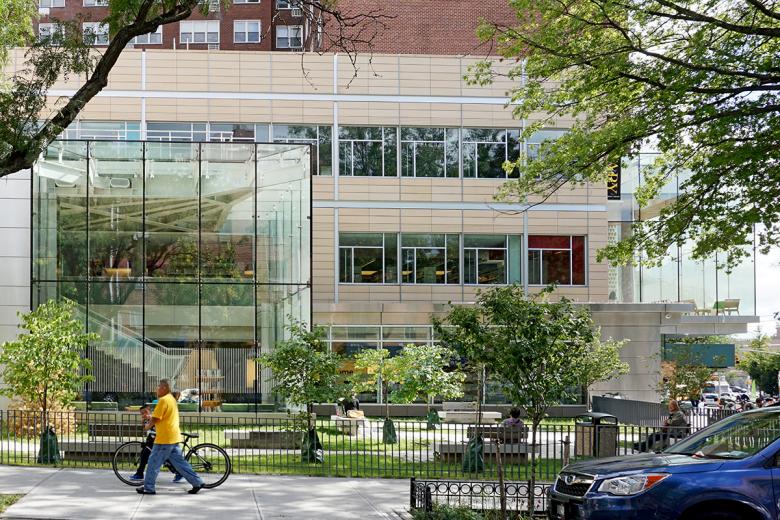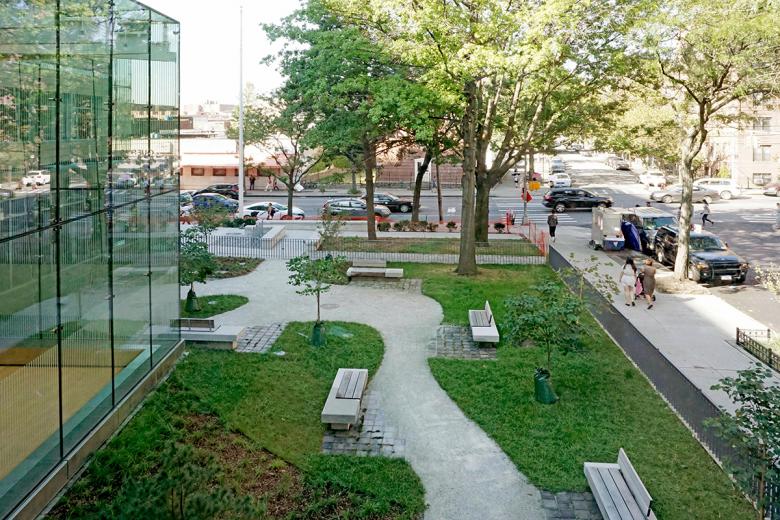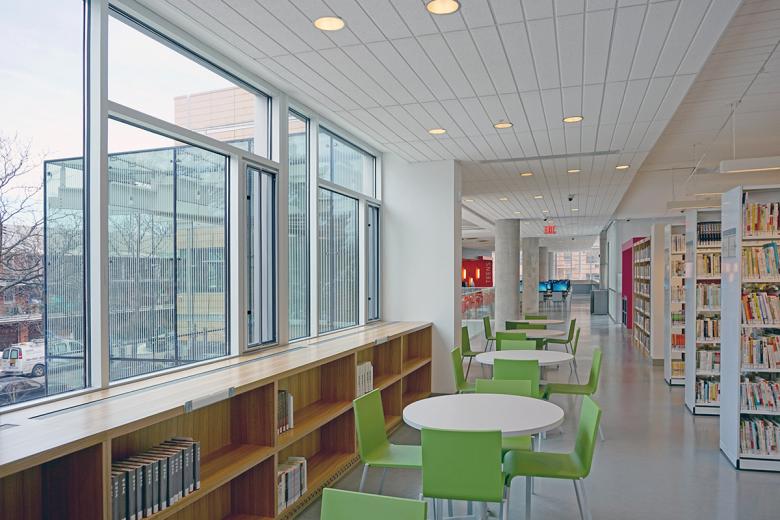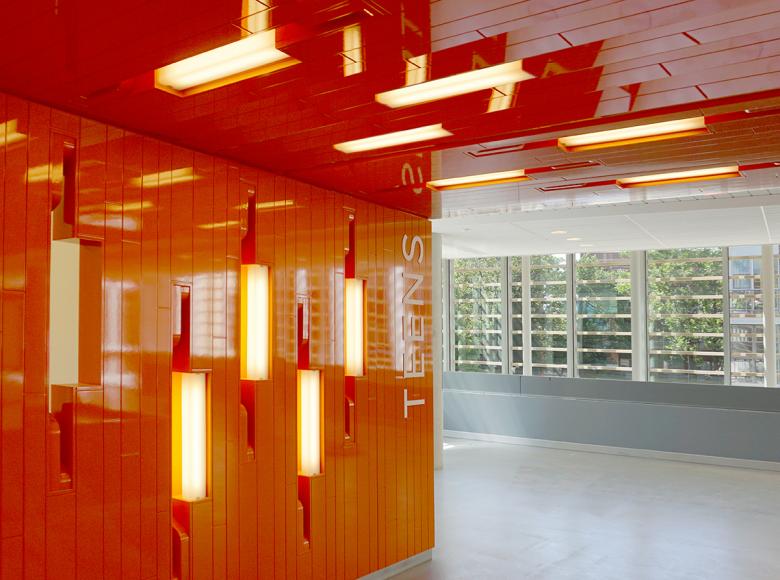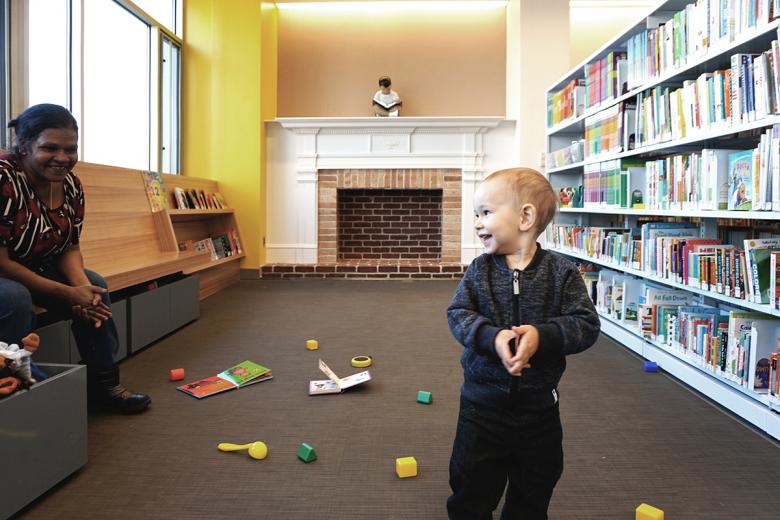Marpillero Pollak Architects
Elmhurst Branch Library
More than a dozen years in the making, the Elmhurst Branch Library in New York City's borough of Queens is an important civic space that caters to the highly diverse community. Open since the last month of 2016, the library is a bustling space that uses color to orient patrons, landscape to further social interaction, and transparency to connect the library to the surrounding neighborhood. Marpillero Pollak Architects answered a few questions about the project.
Project: Elmhurst Branch Library, 2016
Location: Elmhurst, Queens, New York
Client: Queens Borough Public Library, NYC Department of Design and Construction
Architect: Marpillero Pollak Architects
Design Principal: Sandro Marpillero
Project Architect: Linda Pollak
Project Manager: Taigo Itadani
Project Team: Kimberlae Saul, Mark Allan Blumberg, Kara Koirtyhan, Chris Eidt, Matthew Saacke, Anne-Rachel Schiffmann, Kim Letven, Cheng-Yi Ling, Karl-Erik Larson, Nicole Portieri
Structural Engineer: Severud Associates
MEP/FP Engineer: Ambrosino, Depinto & Schmieder
Cost Estimator: Accu-Cost Construction Consultants, Inc
LEED Consultant: Steven Winter Associates
Code Consultant: Design 2147, Ltd
Spec Writer: Construction Specifications
Elevator Consultant: Jenkins & Huntington, Inc
Geotechnical Consultant: GZA GeoEnvironmental
IT/TEL Security Consultant: TM Technology Partners, Inc
Acoustic Consultant: Shen, Milsom & Wilke
Interior Signage: T-squared Design, Inc
Contractor: Stalco Construction, Inc
Artist for Percent for Art Program: Allan McCollum
Building Area: 30,500 sf
What were the circumstances of receiving the commission for this project?
The project is the largest outcome of the NYC Department of Design and Construction Excellence Program for small firms. MPA was a member of the first two cohorts of the city’s Design Excellence Program, created by Commissioner David Burney of the Department of Design and Construction. MPA received the commission for Elmhurst Library through a mini RFP (Request for Proposals), at which time the project was a renovation and addition.
Please provide an overview of the project.
With 80,000+ users, speaking more than 57 languages in their homes, Elmhurst Library serves the most diverse community in New York City. The new library is now the busiest branch in Queens Library’s network of 64 community libraries, with an expected circulation of more than 1.2 million items per year.
Elmhurst Library, as it was designed by Lord and Hewlett Architects in 1904, was one of thirty-nine New York City branches funded by Andrew Carnegie. Subsequent modifications to the library, to accommodate the needs of its steadily growing community, compartmentalized and fragmented its spaces.
In 2004, when our project began, Elmhurst library suffered from an extreme shortage of space for adult and teen reading, computers, children’s programs, adult learning, and meeting/gathering. An adjacent, tall 1980s apartment building shaded the historical community park, causing decline of existing planting.
The new 30,500-sf facility replaces the 1904 Carnegie building and its multiple additions, doubling its size and more than tripling program space, as well as enabling the possibility of a future 16,000-sf addition. As neighborhood anchor and community hub, the new library fulfills Queens Library’s mission of access, transparency, and technology. We worked closely with Queens Library Operations and Maintenance during the design process to support new operational procedures and expanded services, including automated book processing. Double height spaces create unique reading areas.
Two suspended structural-glass reading rooms position patrons in the larger environment, glowing as luminous beacons after dark. The Broadway Cube is above an urban thoroughfare; the Park Cube sits within the renewed Community Park. The two Cubes are calibrated to relate with the scale of the historical fabric. Through use of innovative materials and systems, and inclusion of public art, the Cubes invite people to consider themselves as participants in the process of supporting and enhancing the Elmhurst community’s rich ethnic diversity.
What are the main ideas and inspirations influencing the design of the building?
The library’s design maximizes accessibility to a wide range of programs, integrating the performance of architecture and landscape to establish relationships between inside and outside. The Broadway Cube, visible from afar, provides the new library with a presence on Broadway. The "Spine," with its Sparkle Grain concrete paving, extends from the entry plaza along the length of the building, bringing the city into the interior.
How does the design respond to the unique qualities of the site?
Elmhurst Library seeks to be a model for community/branch libraries in the way in which it integrates environmental and human health and sustainability, and affirms the neighborhood’s diversity of scale, building type, and history.
Elmhurst Library’s 11,500 square feet of community-friendly outdoor program spaces include a 24/7 Entry Plaza with WiFi, a Community Park, a Learning Garden, and a Children’s Terrace. There are also 1,500 square feet of green roof areas, visible from within the building. The building’s Z-shaped massing, with its transparent center, maximizes connections between inside and outside, institution and city.
How did the project change between the initial design stage and the completion of the building?
The project began as a renovation and addition, yet, following a cost benefit analysis, a pre-preliminary report (adopted by DDC as a primary reference) and the first stage of schematic design, it became clear that the library’s needs in terms of space for books, media, people, and technology would be best served by a new building. In collaboration with Queens Library and the DDC, MPA engaged stakeholders in focus groups, workshops, and interactive visioning sessions, in a design process that also included peer reviews.
Following the decision to undertake a new building, meetings with neighborhood groups brought about Elmhurst Library Remembrance Project, including creation of a room for local history, the Elm-paneled Carnegie Reading Room, displays of historic drawings and photographs, and the restoration and reconstruction of the original Children’s Fireplace.
Our involvement with Active Design initiative informed integration of horizontal and vertical circulation systems, including installation of Allan McCollum’s artwork in stairs and elevators, and creating oversized landings with corner windows at the main stair, overlooking the Community Park.
Was the project influenced by any trends in energy-conservation, construction, or design?
Elmhurst Library is a Case Study for the NYC Active Design Guidelines, facilitating physical activity in support of health and wellbeing.
The library’s program spaces cater to its diverse constituences. A system of colorful portals contributes to identity, supports orientation, and stimulates interaction among diverse users.
A separate entrance allows the building to operate after-hours as community hub and adult learning center, offering ESOL and other kinds of classes. In the main stair, wide landings with corner windows overlooking the park provide further opportunities for social interaction.
The project achieved a LEED Silver rating through advanced environmental controls, efficient lighting, and material sourcing, including the re-use of the bricks salvaged from the original Carnegie building.
What products or materials have contributed to the success of the completed building?
The building’s exterior envelope is a terracotta rain-screen with aluminum inserts marking floor slabs and integrating the rhythm of windows. The rain-screen wrapper forms a backdrop for two suspended structural glass reading rooms: the Cubes.
The Cubes’ radical transparency works from outside to inside, maximizing their visibility as desirable destinations, and from inside to outside, situating library patrons simultaneously within building and city/landscape. The Cubes, which glow as luminous beacons after dark, are calibrated to relate to the scale of existing historical fabric, including the 1776 St James Parish Hall across Broadway. The Park Cube provides passersby a view into the library’s two main floors and the special stair that connects them. The Broadway Cube, floating above the Main Entry, announces the library’s presence from afar.
Email interview conducted by John Hill.


